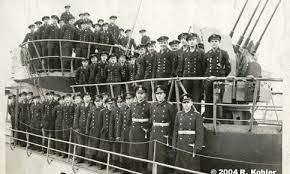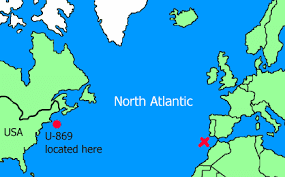A Watery Grave off the Jersey Shore: The Mysterious Story of the Sinking and Discovery of Nazi Submarine U-869 in Point Pleasant NJ
It is the summer of 1991 and adventurous, pioneering and some would even say fool-hardy wreck diver and ship’s Captain Bill Nagle has been hearing rumors of a mysterious, unidentified World War Two era wreck located somewhere off the coast of the Jersey Shore.
Fisherman, ship’s captains, even casual weekend sailors in and around Point Pleasant Beach, New Jersey, have reported sighting what they say is a Nazi wreck not all that far from shore.
Local New Jersey mariners have taken to calling the mysterious wreck, which many have said is that of a possible submarine, a German U-boat-- the U-Who?.
Despite the best efforts of researchers both in and outside of academia, no one has been able to locate either a German or an American record of a U-boat having been sunk, intentionally or accidentally so close to Point Pleasant Beach at any time during the Second World War.
Bill Nagle, along with his diving partner, experienced wreck diver John Chatterton, set off in the summer of 1991 to discover, once and for all, the truth behind the rumors of the existence of the mysterious sunken Nazi U-boat known jokingly as the U-Who?.
Though Nagle and Chatterton, who were based out of Brielle, New Jersey, had both heard rumors of World War Two wrecks at the bottom of the ocean somewhere nearby, neither was convinced that their expedition would succeed. In fact, many friends and acquaintances have reported that Captain Nagle himself was pretty certain that if there was an unknown World War Two era wreck off the coast of Point Pleasant, than it was probably nothing more than one of the countless decommissioned ships that the United States Navy intentionally sunk to promote to the development of marine life along the American coastline.
But never being one to back down from a challenge, and having already made a name for himself as a fearless wreck diver, Bill Nagle thought, What the hell?, and decided to go for it anyway despite his reservations.
And sure enough, on September 2, 1991 Nagle and Chatterton along with a team of divers and researchers located the wreck of a Nazi submarine about 60 miles off the coast of Point Pleasant, New Jersey.
In his final report on the discovery, not completed until nearly seven years later in 1998, diver John Chatterton stated that the team had decided to investigate the site because it had, “Originally been suggested to Captain Nagle by a local fishing boat captain who was curious about the site he had been fishing for years…it was relatively unknown and had never been visited by divers.”
When Chatterton, Nagle and the other divers descended to the wreck they discovered the remnants of a submarine resting at the bottom of the ocean at a depth of approximately 77 feet.
Everything aboard the wreck remained intact, including the remains of the German submariners whose bodies had been trapped inside so long ago. But with no identifiable markings located on the outside of the wreck, it was impossible to tell exactly what German U-boat the divers had discovered off the coast of New Jersey.
 |
| Nazi dinnerware discovered aboard the wreck |
Nagle, Chatterton and their team stuck with calling it the wreck of the U-Who?, and they sought to use the remains of the Nazi sailors still aboard to help them identify the submarine. At the time of its discovery the closest known Nazi U-boat to have been sunk off the coast of Point Pleasnt, New Jersey, was said to have went down to the bottom of the Atlantic a full one-hundred and fifty miles away from where Nagle and Chatterton had made their discovery.
Not only were researchers hampered by the fact that no known historical record existed of a German U-boat having gone down in the area where Nagle and Chatterton had made their discovery, but research efforts were further complicated by the fact that the wreck site was both extremely deep, and extremely unstable making it, to this day, one of the most dangerous wreck sites to dive in the continental United States.
In fact, three divers have lost their lives exploring the wreck of the German mystery U-boat off the coast of Point Pleasant Beach, New Jersey, in the thirty plus years since Nagle and Chatterton first made their discovery and all maritime authorities advise that no one even so much as attempt to dive the wreck regardless of their skill or experience level.
Tragically, Bill Nagle himself would die only two years after first discovering the wreck, at the young age of forty-one in 1993 due to complications from alcoholism.
 |
| Bill Nagle |
John Chatterton along with a team of other experienced divers would continue to regularly dive the wreck for nearly six years in an attempt to identify the mysterious unknown Nazi U-boat off the coast of New Jersey.
Finally, on August 31, 1997 the dive team led by Chatterton got the breakthrough they’d been hoping for.
On that day, John Chatterton and fellow diver Richie Kohler found three one-inch long ship’s ID tags dangling from toolboxes located in the submarine’s electric motor room. Additionally, just prior to discovering the ID tags the dive team had also found a butter-knife with the name HORENBURG carved into the handle.
Chatterton and Kohler were able to identify the mysterious wreck off the coast of Point Pleasant, New Jersey, as being that of Nazi submarine U-869 .
 |
| Ship's ID tag for U-869 |
U-869 was first launched by Nazi Germany in 1944. On February 11, 1945 U-869 was dispatched on combat patrol. On February 28, 1945, or a little over two weeks after leaving her home port in Germany, U-869, along with 56 members of her crew, all but one survivor, would go down to the bottom of the Atlantic Ocean about sixty miles off the coast of Point Pleasant Beach, where she would remain, unreported by anyone, until being rediscovered by the team led by Nagle and Chatterton nearly fifty years later in 1991.
In one last, ironic twist of fate regarding U-869, the lone survivor was a radio officer named Herbert Guschewski. When U-869 was deployed on combat patrol in February of 1945, Guschewski was left behind in the hospital sick with pneumonia. Ironically, since there was no official report on what ever happened to U-869 from either the Nazi’s or the allies, Guschewski was never sure what had happened to the fellow crewmen until April of 1999 when he happened to see a documentary about the discovery of the wreck of U-869 on PBS. After this episode Guschewski contacted the show’s producer and stepped forward as the lone survivor from the crew of U-869.
 |
| Herbert Guschewski 1944 |
Officially, after investigating evidence from the wreck and veterans testimony, a report by the United States Coast Guard concluded that the German submarine U-869 had been sunk by two American destroyers, known to be in the area at the time, about sixty miles off the coast of New Jersey.
The official report states that officers and sailors aboard the two American destroyers used depth charges to attack the submarine, but given the fact that the attack occurred in the middle of the night on February 28, 1945, and that no tell-tale signs of the U-boats having been destroyed could be visually confirmed, both ship’s captains neglected to file a report about engaging a Nazi U-boat that night.
For their part, Nagle, Chatterton, Kohler and almost all of the divers involved in the discovery of the wreck of U-869 believe that the Coast Guard’s theory is pure hogwash, and they assert that for even one American naval vessel to engage an enemy sub regardless of the result and to not file a report of some type would be a grievous violation of military protocol, let alone two.
It is the belief of the dive team that discovered the final resting place of U-869 that the submarine was destroyed by two of its own torpedoes which accidentally exploded in their tubes when the Nazi U-boat attempted to sink the two destroyers already mentioned in the Coast Guard report. Since, the divers contend, the sinking of U-869 was an accident of friendly fire, and since no other German ship’s or submarines were in the area at the time, U-869 in essences blew itself up and sank to a watery grave off the Jersey Shore where it would remain with all hands onboard until its rediscovery nearly fifty years later by Nagle, Chatterton and their team.
Whether U-869 was the victim of an accident, or of depth charges from a United States Navy destroyer, in the end, makes little difference. What does matter is that one of World War Two’s last mysteries, the fate of German U-boat U-869, was solved by a team of intrepid and daring divers only a mere sixty or so miles from the beach at Point Pleasant, New Jersey.
One can only wonder: What other historical mysteries lie in wait to be discovered beneath the waves of the Jersey Shore?
https://www.johnchatterton.com/final-report-on-u869/ The Final Report on the discovery of U-869 by John Chatterton
https://www.pbs.org/wgbh/nova/lostsub/ Official site for “Hitler’s Lost Sub” a PBS documentary on U-869 from April of 199





Great article!
ReplyDelete